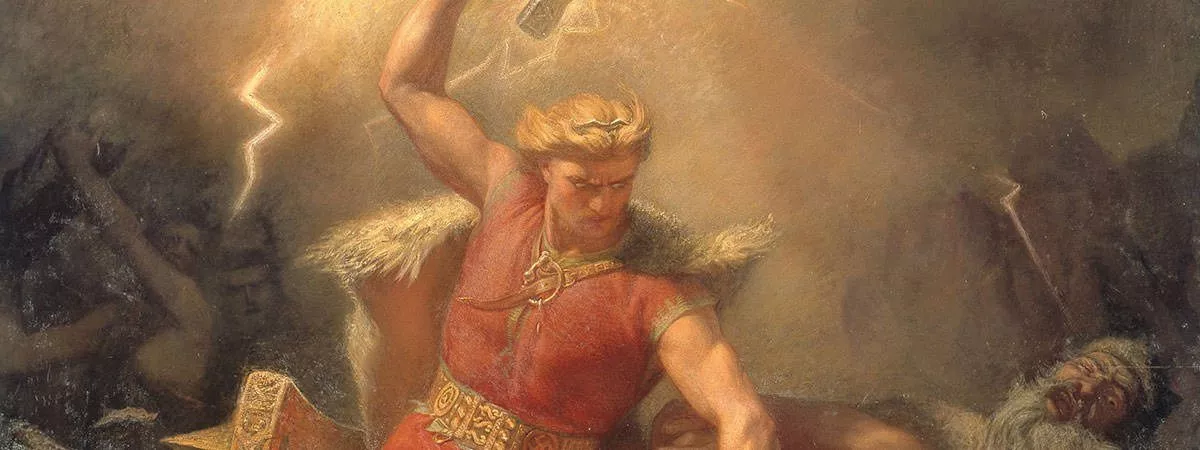The Norse refers to the North Germanic people that lived in Scandinavia and nearby areas before the Christianization of their lands in 8-12 Century CE. The Norse polytheistic religion talks about an immense and sacred tree (Yggdrasil) at the center of the cosmos, around which exist all of creation including the 9 coexistent realms. The Gods reside in the realm of Asgard, the human race in Midgard while the cosmos is populated with various mythological races like giants, dwarfs, elves and land sprits. There are two groups of deities in Norse myths, namely the Æsir and the Vanir, who have historically fought an ancient war for dominance without any conclusive result.
Thor is among the most popular deities in Norse mythology, considered as the God of lightening, thunder, storm, sky and agriculture. He is an Æsir, son of Odin (leader of the Æsir) and Jord (Earth). He is married to the golden haired Goddess Sif (associated with Earth), who is the mother of his son Modi and daughter Thrud. He has another son named Magni, possibly from his affair with the jötunn (a type of giant race) Járnsaxa. Thor is described as fierce eyed, red haired and bearded. His primary weapon being the hammer (Mjölnir). He is often portrayed wearing his belt (Megingjörð) and gloves (Járngreipr), and riding his chariot pulled by two goats, Tanngrisnir and Tanngnjóstr. The Norse stories which feature Thor generally seem to emphasize his simplicity and reliability, besides noting his strength and impatience with delays. Thor is considered as the defender of Asgard and Midgard, the realm of the gods and humans respectively. Legends of his exploits revolve around his relentless slaughter of his foes (many times jötunn) and his fierce battles with his arch rival and nemesis Jörmungandr, the large monstrous serpent that encircles Midgard. Know more about the Norse God of thunder and lightening Thor, through the 10 most famous Norse myths featuring him.
#1 Contest of Abuse Between Thor And Odin
According to a poem called Harbarthsljoth, Thor was once involved in a match of abuse against his father Odin, who was possibly playing a prank on him or testing him or simply punishing him. It so happened that while retuning to Asgard (realm of the Gods) from a journey in Jötunheimr (realm of the Jötnar), Thor came across a river inlet and called for the grey bearded ferryman across the river to ferry him. The ferryman who calls himself Hárbarðr (Odin in disguise) is immediately rude and obnoxious, inciting the God of Thunder. Thor who is simple of nature vis-a-vie a more witty and crafty Odin, initially holds his tongue. But Odin only becomes more aggressive and soon they are into a flyting match (verbal abusive battle) where Odin calls Thor a poor peasant without pants and refuses to ferry him. He goes on further to accuse Sif (Thor’s wife) of infidelity and calling Thor a cuckold. All the while, Harbard compliments his own sexual prowess, bravery and magic, while questioning Thor’s own worth, finally asking Thor to “go where the fiends will get you.” Thor is seen on weaker ground in the contest, he appears shocked and is unable to oppose with witty retorts, but he nonetheless calls Harbard variously a peasant, a pervert, and a man-ling, ending with “I’ll reward you for refusing to ferry me, if we ever meet again.”
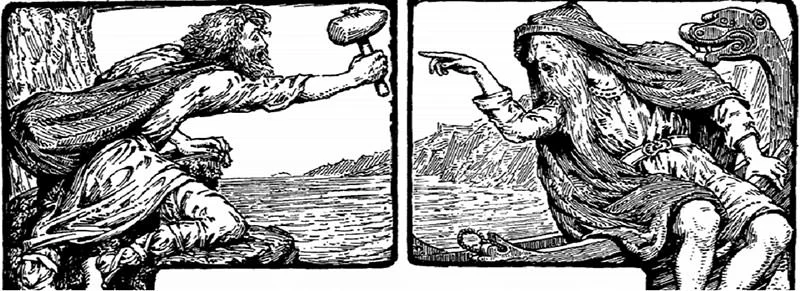
#2 Thor’s Hammer Goes Missing
According to the Norse comedic poem Þrymskviða, Thor once lost his legendary hammer Mjölnir, which was in fact stolen by a jötunn (a type of giant race) named Þrymr (Thrymr). This unprecedented situation led him firstly to Loki (trickster shapeshifting God) and then to Freyja; a Vanir and mother Goddess of fertility, love, beauty, magic, war and death. Freyja agrees to help Thor and Loki and lends them her cloak of falcon feathers. Using the cloak Loki flies off to the realm of Jötunheimr, where he meets up with the jötunn Thrymr sitting on a hill. The jötunn admits to stealing the mighty Mjölnir which is hidden by him eight leagues beneath the earth. Thrymr is willing to return the hammer but in return he wants to have the beautiful Freyja brought to him as his wife.
When Thor and Loki ultimately request Freyja to put on the bridal head dress, the Goddess is outraged at the suggestion. She goes into a fit of rage causing the halls of the Æsir to tremble in her anger, and her necklace, the famed Brísingamen, falls from her. The Gods and Goddesses of Asgard finally gather to discuss the grim situation where the God Heimdallr (guardian God) suggests that Thor should dress as the bride, wear the necklace Brísingamen and retrieve the hammer. Thor initially rejects the idea, but Loki points out that this will be the only way to get back Mjölnir, without which the jötnar will be able to invade and settle in Asgard. Thor has no option but to relent and is thus dressed up like a bride. Loki on the other hand offers to disguise himself as Thor’s maid and the duo travel to Jötunheimr together.
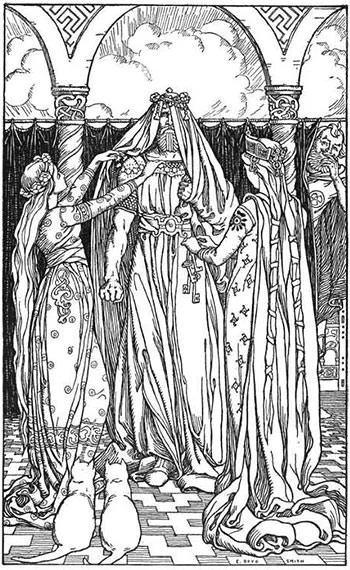
An elated Thyrmr lays out a feast to welcome his new bride, where Thor eats and drinks ferociously arousing the suspicion of Thyrmr and the guests. Loki (the maid) is however up to the task and explains that Freyja has not eaten for several days in her eagerness to marry Thyrmr. Then Thyrmr lifts the veil to kiss his bride and is shocked to see terrifying burning eyes staring back at him. Loki jumps to Thor’s rescue yet again and explains that Freyja has not slept for eight days in her eagerness to meet her new husband. Thyrmr is bluffed again and finally calls for his bridal gift for Freyja, the Mjölnir as he had promised. Thor laughs internally when he sees his hammer, takes hold of it and strikes and kills Thyrmr and his guests, thus reclaiming his weapon.
#3 Thor Tricks A Dwarf
The dwarves were a race of creatures known in many Germanic cultures, with the Old Norse referring to them as dvergr. The dwarves were short, burly creatures who lived in their underground homes and were reputed to be great metalworkers and forgers. According to the Norse poem Alvíssmál (Talk of Alvíss), Thor tricked a dwarf named Alvíss (all wise) to his doom, upon realizing that the dwarf seeks to marry his daughter. In the poem Thor meets up with a dwarf who talks about his contract with the Gods, who have promised him a bride. Thor soon finds out that the marriage Alyiss is talking about is to his daughter. Unimpressed by the groom Thor points out that the wedding agreement was made among the gods while Thor (the father) was away, and that the dwarf must seek his consent. To do so Alviss must now answer all of Thor’s questions. In a long question and answer session, Thor asks Alvíss of the earth, heaven, moon, sky, cloud, sea among others. The dwarf describes natural features as they are known in the languages of various races and gives an amount of cosmological lore. However this was all a trick of Thor to buy time and allow the sun to rise. As the sun rises Alvíss is turned into stone and Thor accomplishes his goal. It is interesting to note that the idea that dwarves cannot be in the sunlight is not noticed in any other surviving Norse literature, and many dwarves seem to live aboveground as per other myths.
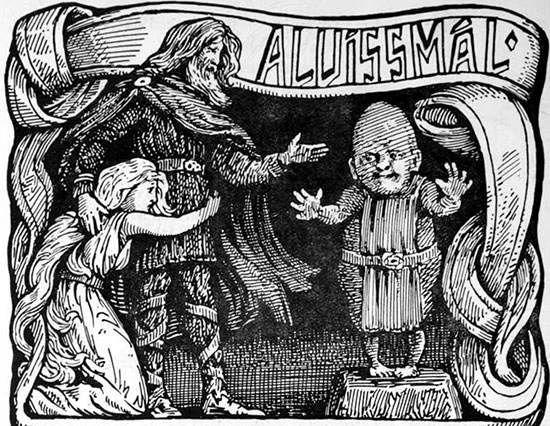
#4 Battle With Hrungnir
In Norse mythology Hrungnir (translated as “brawler” or “strong man”) is a jötunn (a type of giant race) who is described to be very large and made of stone. Once while Odin (leader of Æsir Gods) was riding his horse Sleipnir in the realm of Jötunheim, he came across Hrungnir, who was mounted on his horse Gullfaxi. The two engaged in a verbal spat over the fineness of their own horses which finally resulted in a bet to establish their claims, a race between the two to Asgard. The race was close and Odin was the winner but unknowingly he had given access of Asgard to a jötunn. When Odin invited Hrungnir for a drink, the intoxicated jötunn threatens to kill all the Gods except Freyja (Odin’s wife) and Sif (Thor’s wife), whom he intended to take home with him to Jötunheim. This was an insult which angered the Gods and Thor was called upon to remove the unwanted guest. Thor and Hrungnir ultimately agreed to settle things with a duel, where Thor emerged victorious smashing the jötunn skull into several pieces with his hammer. A complicated situation however arose when Hrungnir fell in battle and Thor’s neck was accidentally trapped under the jötunn’s foot. The Gods tried to help Thor but none was able to find the strength to lift Hrungnar’s foot. Finally it is Thor’s own son Magni (from the jötunn Járnsaxa) who was just three nights old, who came forward and lifted the foot off his father’s neck. Thor is elated and predicts that his son would become great while also gifting Hrungnir’s horse Gullfaxi to Magni. Odin however disapproved of this, wishing that gift was presented to him.
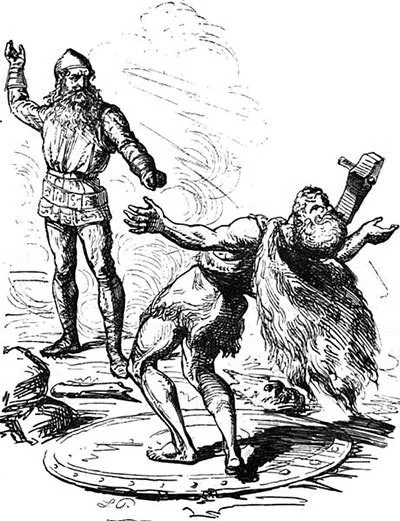
#5 Legend of Thor’s Hammer And Sif’s Golden Hair
In Norse legends, Sif is a beautiful Goddess with golden hair who is married to Thor. Loki on the other hand is a mischief making God known for often causing trouble among the Gods. He is however considered useful for he makes up for his mischief with great favours and gifts. According to Snorri Sturluson’s Skáldskaparmál, once in mood for a great prank Loki cut off Sif’s hair while she was sleeping. This naturally enraged the God of thunder who was quick to grab and confront the mischief maker. With the situation getting out of hand, Loki promised Thor a replacement of the Sif’s hair made by the dwarfs of Svartalfheim (realm of the dwarves). Thor was initially sceptical but agreed after being convinced by Loki that Sif’s new hair would be of real gold, and thus even more beautiful and luxurious than her natural hair.
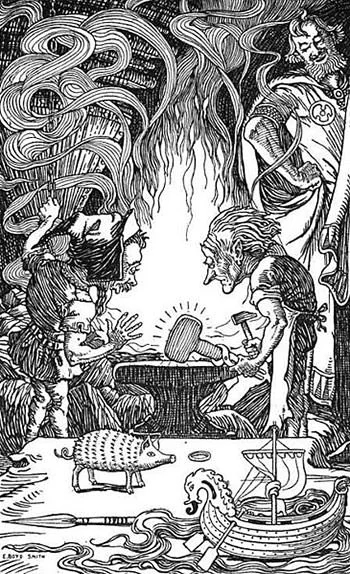
To fulfil his promise Loki approached the dwarf Ivaldi with the request. The sons of Ivaldi not only crafted an exquisite headpiece for Sif but made other gifts for the Gods as well. These included the foldable ship Skiðblaðnir for Freyr (God of prosperity, peace and kingship) and the spear Gungnir for Odin (leader of Æsir Gods). Though his task was complete, the mischief maker in Loki wondered what else he may extract out of the talented dwarfs. He thus approached the brothers Brokk and Sindri (or Eitri) and bet his own head that the craftsmen could not better the work of Ivaldi’s sons. Taking the challenge, Sindri was first on the job and despite being bitten by a fly on his hand he managed to create the Gullinbursti for Freyr, an exquisite golden boar who was faster than any horse apart from Odin’s Sleipnir. Brokk then created another perfect item despite the fly biting his neck, the golden ring Draupnir for Odin which created eight new rings of gold every nine nights. Finally Brokk began work the Mjölnir for Thor, a great battle hammer that never missed its target and flew back to its owner’s hand after it made it’s hit. This time Brokk was bitten on his eyelid, and being blinded by the sting the dwarf made the hammer’s handle slightly short to be considered perfect. Thus was born the Mjölnir, among the most feared weapons in Norse mythology wielded by Thor. Interestingly it was the shapeshifting Loki that had taken the shape of a fly to save his own head; and succeeded only by a slim margin.
#6 Tanngrisnir And Tanngnjóstr
According to Norse compilations in the poetic Edda and prose Edda, Thor had a chariot which was pulled by two goats named Tanngrisnir (teeth barer) and Tanngnjóstr (teeth grinder). What was unusual about these goats was that whenever the God of thunder was hungry and there was no food around, Thor could consume these goats for nourishment and then magically resurrect them the next day by using his hammer Mjölnir. Once while Thor was travelling with Loki, the duo had to take refuge in the house of a peasant who offered them lodgings for the night. For dinner Thor slaughtered his two goats, skinned and cooked them, and invited the peasant and his family to share the meal. Thor then instructed them to throw the bones of the goats onto the goatskins so that he may resurrect the goats in the morning. The next day when Thor went about with his magic something was amiss, one of the goats had gone lame in the hind leg. Thor was enraged realizing that someone had mistreated the bones of his goats. The culprit had been the peasant’s son Thjalfi, who had taken one of the goat’s ham-bones and used a knife to split it open, breaking the bone to get to the marrow. Terrified for angering the God of thunder, the peasant begged for forgiveness and offered his two children Thjalfi and Röskva in service of Thor, which the God accepted.
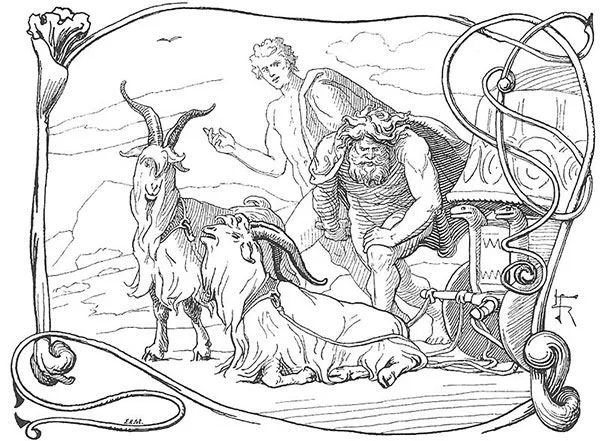
#7 Encounter With Útgarða-Loki
Among the more famous myths regarding Thor is of his encounter with Útgarða-Loki (Loki of the chaotic, wild). Once while travelling with Loki and his two newly acquired servants (Thjalfi and Röskva), Thor crossed an ocean and a vast forest in an attempt to reach Jötunheimr (realm of the Jötnar). One night as the four were seeking shelter, they came across a large hall and decided to rest there. They were however soon awakened by a great earthquake, and rushed out to discover a huge sleeping jötunn (a type of a giant race) whose snores were shaking the very earth. Thor used his hammer to finish off the jötunn, but the blow seemed to have no impact other than just waking him up. The jötunn introduced himself as Skrymir (boaster) and picked up his glove which to everyone’s amazement was the hall the group were sleeping in. Skrymir then offered to accompany the group in their journey, which Thor accepted.
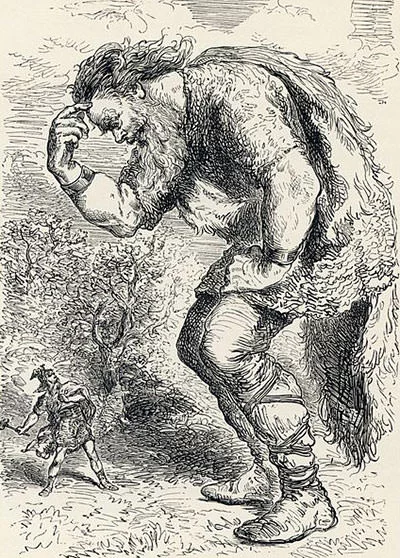
The next night as the giant slept, Thor tried to fetch the food which was in Skrymir’s bag and was unable to untie the knots of the pouch. Frustrated and hungry, Thor struck the giant again on his forehead in order to kill him, but the jötunn awoke calmly and asked if a leaf had fallen on his head. Later in the night no one was able to sleep due to Skrymir’s snores and an annoyed Thor struck the giant yet again. This time the jötunn awakened and asked if an acorn had fallen on his head. Finally the next day Skrymir took leave of the group after warning them about Útgarða-Loki (Loki of the chaotic, wild). Thor and company then proceeded on their journey until they reached the castle of Útgarða.
The castle was massive and no one had seen such a castle before. The gates were shut but the four travellers realized that they were small enough to squeeze through the gate bars. Once inside, the group walked into a dining hall filled with large sized people, the gathering presided by none other than the jötunn Útgarða-Loki. The giant was quick to recognize his new guests and mocked them for their diminutive size while challenging them to prove their worth. Loki (not Útgarða-Loki) was the first to accept claiming that no one can eat faster than himself and thus setting up his competition with someone named Logi. A trough of meat was set before the contestants, who were on its either side. The objective was to consume the meat and reach the centre first. Both the contestants managed to reach the centre at the same time but Logi has eaten the meat, the bones, and even the trough itself, thereby defeating Loki.
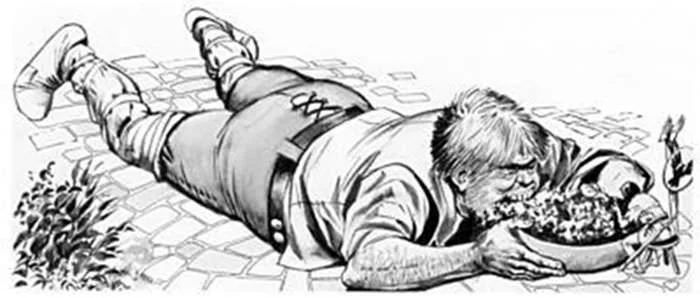
The second competition was a race between Thor’s swift servant Thjalfi and Hugi, where Thor’s companion was clearly of no match despite his commendable effort. Finally it is the turn of Thor who claimed that no one could drink faster than him. He was thus handed a horn full of drink with Útgarða-Loki claiming that the one who could finish the horn in one go was considered a great drinker, one who could do it in two was considered fair, but no one in the gathering was poor enough to do it in three. Thor took a giant gulp and failed, he took another and failed yet again, finally giving up. Útgarða-Loki then challenged Thor to just lift his cat and Thor was found wanting again, only managing to lift it’s paw. Finally Thor put up a challenge for a wrestling match. This time Útgarða-Loki called upon his old nurse Elli for the challenge. As the two wrestled Thor discovered that the more he tried the harder the battle would become, finally being brought down to one knee. After being humiliated in all the challenges Thor and his companions were treated hospitably and shown off to their rooms to retire for the night.
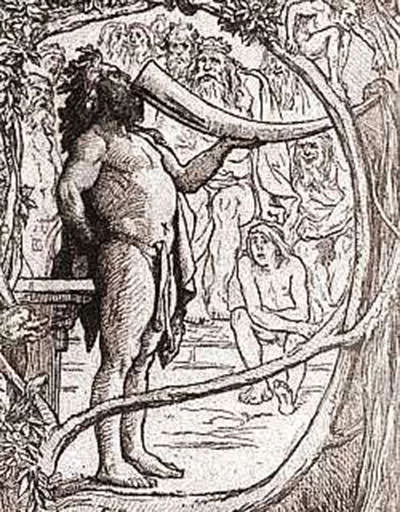
The next morning Útgarða-Loki escorted his guests out of his castle and confided in them about his wish; that they never ever meet again. He further reveals that it was him who had initially appeared before them as the jötunn Skrymir. Any of the three blows that Thor had attempted on Skrymir would have proven fatal had they landed on him. The blows were in reality magically evaded and their immense power had flattened the ground and created 3 square valleys. The contests too were just an illusion and Loki had competed in his eating competition with the all consuming wildfire itself. Thjalfi on the other hand was racing against thought and Thor’s drinking horn reached the oceans itself. The God of thunder in his drinking had in fact lowered the ocean levels and caused tides. The cat that Thor attempted to lift was in actuality the world serpent named Jörmungandr that encircled Midgard (realm of humans), and everyone was terrified when Thor was able to lift the paw of this “cat”. Finally Thor’s last wrestling match was with old age itself, and there is no one that old age cannot bring down. Thor is enraged upon the trickery of Útgarða-Loki and turns to strike him with his hammer only to discover that the illusionist has vanished along with his castle.
#8 Loki Insults Thor
The Norse composition Lokasenna is a flyting match (verbal battle) between the Æsir Gods and Loki, during a feast given by the sea God named Ægir (aka Gymir). Thor is generally absent during the feast but arrives later and immediately warns Loki to be silent or else Thor intends to hammer Loki’s head off his shoulders. Loki now shifts the focus of his abuse on the God of thunder questioning Thor’s anger and taunting him, saying that Thor will not be so bold to fight against the wolf when he swallows Odin (leader of Gods and Thor’s father) at Ragnarök (end of time). Thor threatens Loki again saying he would put him on the road to the east where no one would be able to see him. Loki taunts Thor and makes fun of Thor’s journeys to the east where he cowered under the glove of the giant Skrymir. Thor threatens Loki again and says that he would break his bones. Loki responds that he intends to live long and teasingly reminds Thor that despite all his strength the God was unable to open the straps of Skrymir’s bag. Thor is furious by now and threatens Loki yet again with the Mjöllnir saying that he would send the later to Hell, below the gates of Nágrind. This time Loki leaves saying that he has shown the Gods and their sons the sharp edge of his tongue. Loki also compliments Thor before leaving, saying that he leaves the hall only because of Thor, because the God’s threats are the only ones he actually fears.
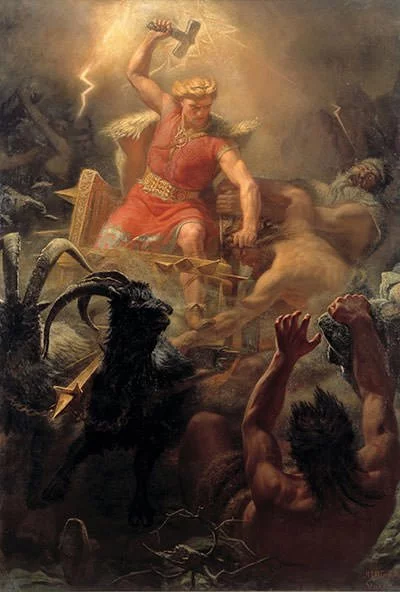
#9 Hymir’s Cauldron And Fishing For Jörmungandr
The Æsir Gods and the jötunn (a giant like race) were mostly portrayed as enemies in Norse myths. However Aegir and Ran were among the few exceptions, two gracious giants that lived below the sea and were known for their habitability. Once the two jötunn agreed to host a feast for the Gods making the later delighted. However, there was a condition, the Gods were to provide the hosts a cauldron large enough to brew mead for all the invited guests. There was only one vessel in the nine realms that fitted that description, and it belonged to the jötunn Hymir. Thor being the bravest of the Gods volunteered for the task and set out to Hymir’s lodgings.
Upon Thor’s arrival the jötunn slaughtered two of his large bulls for his guest, and was irritated when Thor consumed both of them in one sitting to satiate his legendary hunger. This led to the irked giant declaring that the duo would need to go fishing to arrange for the next day’s meal. In the morning, Hymir sent Thor to procure bait for their hooks. Thor was quick to accomplish the task by simply going to Hymir’s pastures and slaughtering one of his largest remaining bulls. The jötunn was further agitated at the rash and simple Æsir God. He hoped that Thor’s strength would be more useful in the fishing expedition. As the duo were fishing they managed to catch two large whales but, instead of returning, Thor began to row the boat further into the sea. Hymir was terrified and warned Thor that the giant Midgard serpent Jörmungandr lurked under the waters ahead. Thor was however unperturbed hoping for an encounter with his arch nemesis, he dropped the oars and cast his line into the water. After a period of silence luck shined on the God of thunder and he felt a mighty tug on the line. Thor pulled hard and the boat shook violently to the dismay of a terrified Hymir. Thor persisted with his feet planted firmly, soon the boat planks were giving way and the ship was flooding with water. Finally the serpent’s head emerged out of the water with the hook in his venom-dripping mouth. Thor raised his hammer to end the beast but Hymir panicked at this critical moment and cut the line. The howling snake thus slunk back down and escaped leaving Thor furious at his missed opportunity. He thus threw Hymir overboard and then returned to Asgard with the two whales and the cauldron.

#10 Ragnarök
In Norse mythology, Ragnarök is a foretold doomsday event where the worlds would collapse through natural disasters, war of the Gods and other catastrophic events. Ragnarök begins with roosters crowing a warning to the nine worlds of the Norse. Two sons of Fenris the wolf begin the long winter which would last 3 long years, with Sköll swallowing the sun and Hati swallowing the moon. In the third year of the Great Winter, the Gods battle one another to the death of both combatants. The last event of the Great War would see the fight between the God of thunder Thor and his arch enemy Jörmungandr (the giant World serpent that encircles Midgard). Thor would slay the serpent by crushing its head with his hammer but would only survive nine steps following the battle, succumbing to the serpent’s venom. Ragnarök is not the end of all times and beings in Norse mythology, but more like a cleansing, regeneration and beginning of a new era. The earth would rise again from the sea and the worlds would start afresh.
Note: It is important to note that the main sources of Norse literature (Poetic Edda and Prose Edda) come from the writing of the medieval Christian Icelander Snorri Sturluson. The sources can thus at best be seen sceptically for their credibility and reliability in understanding the pre-Christian Norse world view.

